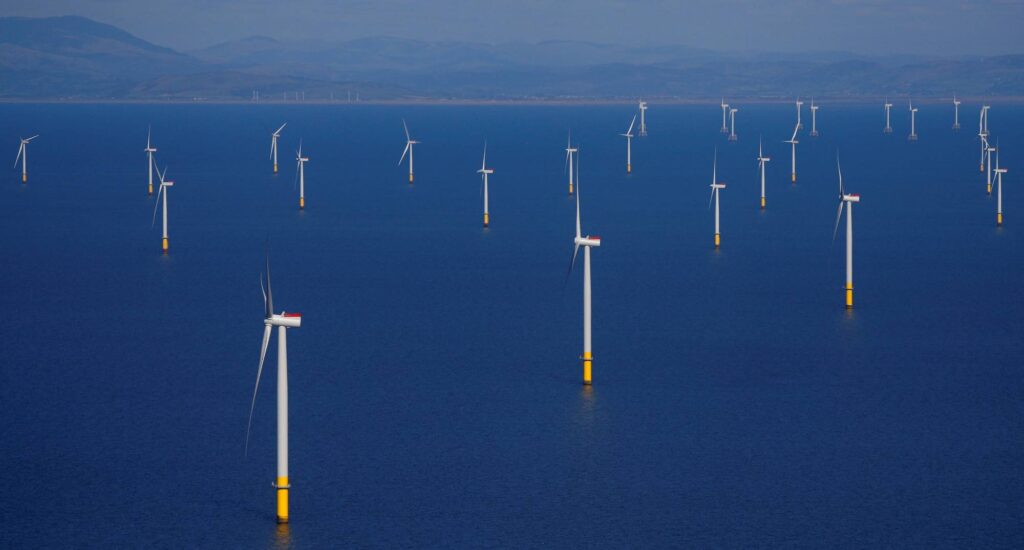Unusually calm and cloudy weather led to resurgence in fossil fuel use in 2021
4 min read
Great Britain’s wind turbines and solar panels both saw a drop in their electrical output in 2021. It was the first drop since 2016 for wind, and the first ever for solar. Our research group tracks energy systems and has extensively studied the existing energy data landscape. This has given us a unique insight into the challenges of shifting away from fossil fuels to lower carbon alternatives. So what should we make of this underwhelming year?
In 2021, about 26% of the electricity was generated from wind and solar, compared to 30% the previous year. This occurred despite a modest increase in the generation capacity to record highs for each technology.
However, this extra capacity could not compensate for unusually low average wind speeds in 2021 which meant wind output fell 12%. From 2001-2020 the average wind speed across a calendar year in the UK was 8.8 knots but from January to November 2021 this value was just 7.8 knots (2010 was a similar year where the average fell below 8.0 knots over the January to November period).
The 7% reduction in solar output was due to 2021 being less sunny than previous years, especially 2020 which was unusually sunny.
The relatively poor wind and solar resource in 2021 was compounded by damage to an undersea cable connection to France and reduced output from nuclear power. This led to an increase in fossil fuel generation to meet demand (mostly gas).
It also meant that for the first time since 2012, more electricity was generated from coal than in the previous year. This was despite two large coal power stations closing or switching to biomass in the past two years (Fiddlers Ferry and Drax respectively), almost halving generation capacity.
Just two coal-fired power stations remain (Radcliffe-on-Soar and West Burton) and both are scheduled to stop burning coal by the end of 2024. However, despite the increase, coal still generated just 1.8% of electrical demand – in the longer term, 2021 should be seen merely as a a bump in the road that eventually leads to a zero coal electrical system.
Even though wind and solar power performed poorly when summed across the whole year, they still helped to drive carbon emissions below 100 grams per kWh for over 800 hours, while generation conditions were favourable.
Planning for net zero
As wind and solar have a different output from year to year, this has to be addressed through the design of energy systems for net zero. After all, these weather dependent renewables will make up a greater fraction of future generation capacity and demand will be much greater due to the electrification of heat and transport.
The system has to account for these variations in output, harvesting and storing extra energy at times of plenty for months or years when the wind and solar resource is much lower. Batteries are better suited to provide system balancing on shorter time scales – hours or days – which leaves a significant challenge of storage over medium and seasonal timescales. Imports can help, both of electricity through cables, or from low-carbon fuels that are shipped or delivered through pipes. Fuels will continue to be particularly suited to this role, as they can be stored at significant scales at lower cost, which is a defining advantage for medium and longer term energy storage.
Petrol panic and record natural gas prices
Data from petrol stations shows that the government was correct to ask consumers not to panic buy. There was enough fuel in the supply chain, and the main problem was a lack of truck drivers to get fuel delivered from refineries to petrol stations.
The data shows that consumers took little notice of this, and filled their vehicles with significantly more fuel than normal. Though this exacerbated an already fragile supply chain, at least the energy was in the form of a fuel, which could be stored and transported around the country. As the chart below shows, over the following weeks, daily deliveries (the blue line) were greater than sales (the orange line) and this allowed stock levels at petrol stations to recover.
It is interesting to consider what might happen in future with electric vehicle demand if forecasts suggest a significant and sustained drop in wind generation that might last for more than a few days. Will consumers be swayed by government advice to manage their charging patterns for the greater good of the wider electrical system, or decide that having a fully charged vehicle is a greater priority?
Natural gas prices were also volatile in 2021 due to a number of economic and geopolitical factors which saw a sharp spike in the wholesale cost of gas from September onwards, in tandem with increased road fuel prices.
Since lots of electricity is generated from natural gas, along with low wind output, the wholesale price of electricity tracked these changes and also reached a record monthly high in September 2021, 2.5 times greater than the previous record set in January 2021.
These price rises are expected to have a devastating effect on fuel poverty which already affects over 4 million UK households and could reach 6 million by this spring. It also highlights the need for the rapid decarbonisation of power, heat and transport, along with an ambitious domestic retrofit program as a means to shore up energy supplies and protect consumers from the fluctuations of fuel prices in global markets.
If wind and solar recover in 2022, we expect to see a record year of generation for these technologies, which might ultimately help to counteract higher international gas prices.
This article was originally posted on Unusually calm and cloudy weather led to resurgence in fossil fuel use in 2021





